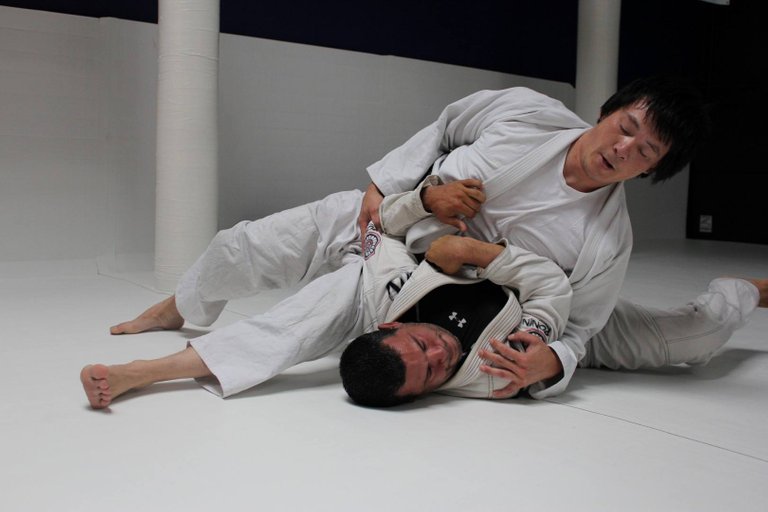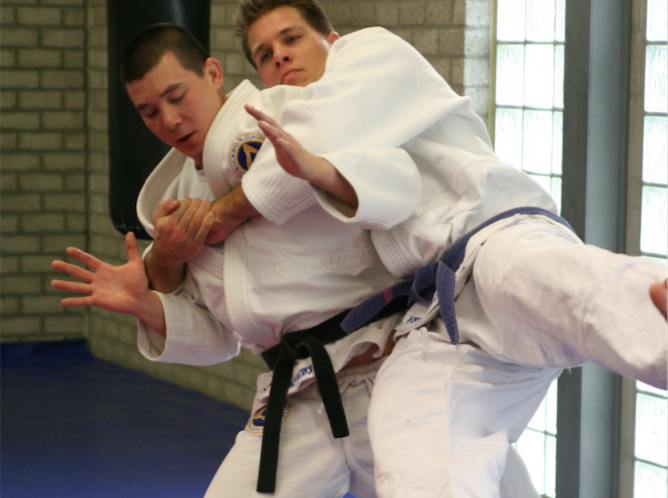Reposted with permission of Henry Akins, the third American to receive a Brazilian Jiu-Jitsu black belt from the legendary Rickson Gracie. Henry trained under Rickson for 15 years and became the head instructor at the Rickson Gracie Academy from 2005 to 2008. Check out Henry's site Hidden Jiu-Jitsu where he shares the inside knowledge of the Gracie family that he picked up from training with Rickson daily for well over a decade.
I remember one of my first exposures to Jiu-Jitsu was watching Royce Gracie fight in UFC 1 back in 1993 (a few months before that I had seen an old grainy vhs copy of a copy of Gracie in Action 1 and 2 so I knew who the Gracie family were and who Royce was). All of the competitors in the event were decorated competitors in their respective martial art, skilled martial artists. The UFC back in those days was a tournament style, no weight limit, no time limit, bare knuckle fight. The only rules were no biting, and no eye gouging. All else was allowed. In those days the UFC really was “As Real As It Gets” except you had to fight 3 game opponents in one night to “win”. Royce Gracie won the first event in under 5 minutes dispatching Art Jimmerson, Ken Shamrock and Gerard Gordeau barely taking a hit. After seeing the effectiveness of Gracie Jiu-Jitsu in action again, I knew I had to figure out a way to learn the art. A year and a half later I had moved to LA to begin training with “The Champion of the Gracie Family” Rickson.
What made me leave friends, family, and girlfriend behind and move half way across the country to learn a martial art was that I believed Jiu-Jitsu was the single most effective martial art. If I was going to dedicate myself to learning any martial art then it should be the the most effective and in those days members of the Gracie family were out testing and proving their art against other styles. Royce and Renzo were fighting in the US and Rickson was fighting in Japan winning no-holds-barred and vale tudo tournaments.

The foundation of Jiu-Jitsu, its core principles and concepts are based on self defense. The ability to stay safe against an opponent no matter how large, no matter what forms of attack they are using and for an indefinite amount of time. That is the reason it is a grappling art with a focus on “position before submission”. The dominant position allows even a smaller and weaker individual to stay safe from taking damage and allow them the ability to inflict damage on their opponent and go for submissions.
I’m thrilled that today Jiu-Jitsu is the fastest growing martial art in the world and more people are being exposed to Jiu-Jitsu then ever but I’m afraid the techniques and training mindset that once allowed a skinny Brazilian to defeat 3 heavier opponents in one night, and shock the world, are being lost.
You see, there is a fallacy these days that jiu-jitsu is not a complete self defense system, that in order to be a complete martial artist you must learn striking combined with wrestling or judo. I completely disagree. While knowledge in these other arts can be extremely helpful, jiu-jitsu in itself is a complete art with kicks, elbows knees and take downs.
The striking is not as comprehensive as arts that focus solely on striking but there is a reason for that. In striking, the larger opponent will almost always have the advantage in reach and power. They have the ability to hit first, from farther out and do more damage. It’s no secret why Anderson Silva, Jon Jones and Conor McGregor have done so well as strikers in their weight divisions, they have some of the longest reach in their divisions (Anderson’s nickname “The Spider” was given to him because he has such long limbs). Jiu-Jitsu was created for the smaller individual to protect them self against a bigger stronger individual so every advantage counts, that’s why the goal is not to stand up and exchange with a larger individual but to close the distance and take the fight to the ground.
The take downs are also not as comprehensive as arts such as judo and wrestling but it doesn’t need to be and here is why. If you look at the most successful competitors in Judo and wrestling they usually have a handful of take downs that they are good at but also 1 or 2 throws or take downs they specialize in. They have trained those few take downs so many times and learned how to set up the take downs from so many situations even when opponents train for months to stop their specialty move they still get taken down with it. These are the most elite competitors training for months to stop a single move they know is coming and they still cannot stop it. John Smith 4 time world champion and 2 time Olympic champion had his low level single, Jordan Burroughs 2 time world champion and Olympic champion has his blast double, Masahiko Kimura had his osoto-gari. Legend has it, he would practice osoto-gari against a tree. Many of his training partners suffered from so many concussions and even lost consciousness they would ask him not to use it. What this tells me is that you can be extremely effective at getting an opponent to the ground with mastery of just a few take downs.

Sadly the way Jiu-Jitsu is being taught and trained at many schools is as an incomplete art forcing students to search for what’s lacking in other martial arts.
What makes the difference??? TRAINING and UNDERSTANDING the Self Defense techniques in Jiu-Jitsu.
Without learning the self defense techniques of jiu-jitsu you are not learning the whole art. Imagine learning karate but without the punches or the blocks.
Almost every physical confrontation will start from the feet so the students knowledge of Jiu-Jitsu has to start from there.
Even though there are not as many stand up techniques in Jiu-Jitsu as ground techniques, the stand up portion is 50% of the fight. When a student is training regularly in the self defense techniques of Jiu-Jitsu, they are learning punch defense from the feet and on the ground, how to close the distance safely and take downs from many different situations. A lot of the take downs come from situations when they are being grabbed by the attacker or the attacker has the upper hand. Along with that there are also many different finishes from the feet including wrist locks, arm locks and many chokes. There is also a limited amount of strikes taught in the self defense. Mostly knees and elbows because the focus is grappling the knees and elbows will be the best tools for a close range fighter. The Jiu-Jitsu self defense curriculum address every aggressive action from an attacker imaginable. In the old days the first few classes for any new student in Jiu-Jitsu were just self defense from the feet. This laid the foundation for everything to follow.
I worked as a bouncer and later doorman at some of the hottest nightclubs in LA for 15 years and I can honestly say my knowledge of the self defense techniques in Jiu-Jitsu has saved my life. You see in that environment, you almost never want to go to the ground because there are broken bottles and glasses all over the floor plus its such a chaotic environment with so many people you never know who is on your side or who might be trying to hurt you. If you end up on the ground with someone you may be getting kicked, stomped, sucker punched, blind sided or getting large shards of glass stuck into your body. By knowing the stand up self defense techniques I had the option whether I wanted to finish the fight from the feet or take the fight to the ground to finish. Most the time I was able to subdue and control someone on the feet and remove them with anyone getting hurt. Its my knowledge and training in the self defense that helped me to be able to stay safe in an environment where I was constantly exposed to danger and gave me the confidence to deal with people in an extremely humane way even when the level of aggression escalated.
I’m very grateful to have been trained and given the knowledge of the self defense aspects of Jiu-Jitsu by Rickson. In fact the main criteria to get my black belt from Rickson was not my level of performance on the ground but my level of knowledge of the self defense from the feet. “A black belt”, he told me, “must know all the self defense so he can teach and empower others.”
Hopefully most of us will never need to use Jiu-Jitsu on the street but the whole purpose of training is to develop the skills necessary so that when you do need it, the skills and knowledge are available and they work. I encourage everyone to make the self defense training a consistent part of your regime. After feeling comfortable with the techniques you can start to add resistance and variation to the situations because just like in training not every time you do the movement it will feel the same, so the resistance and variation trains us how to adapt. If you don’t train in it regularly you lose the sharpness of it and unfortunately in times of need you don’t have time to think, only react.
Remember self defense is the foundation of Jiu-Jitsu and all of the ground techniques naturally flow from situations from the feet. Just like in those early days of the UFC, Royce was not fighting opponents who wanted to start on the ground with him, so he had to train to be comfortable on his feet. It was Royce and his performance in those early UFCs that helped to spur the growth of Jiu-Jitsu to what it is today.
I believe Jiu-Jitsu is still the most effective martial art in the world when it’s trained with the right focus and intention. Self Defense is not just a collection of techniques but a mindset for training. We cannot forget the significance of those early UFC fights. It was to demonstrate the effectiveness of Jiu-JItsu against all other arts so its up to US the practitioners to continue that legacy and mindset.



It sure can! It’s the truest of the forms! Great stuff!
Henry has some serious knowledge. Couldn't agree more with what he's saying. Thank you for sharing it. This makes me want to train my ass off!
Fortunately we have access to all of his stuff through HJJ! Let's train tonight!!
Thanks to your ass we do!! Let's!
Hi! I am a robot. I just upvoted you! I found similar content that readers might be interested in:
https://www.bjjee.com/articles/henry-akins-answers-can-jiu-jitsu-make-you-a-complete-martial-artist/